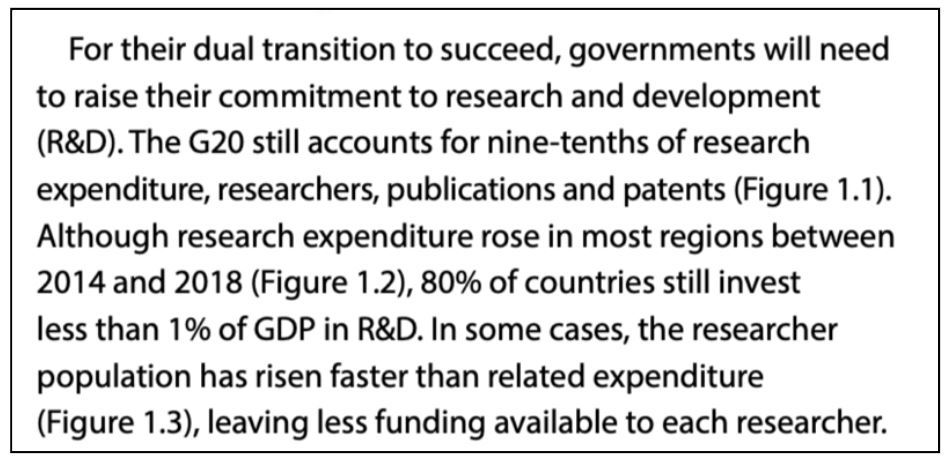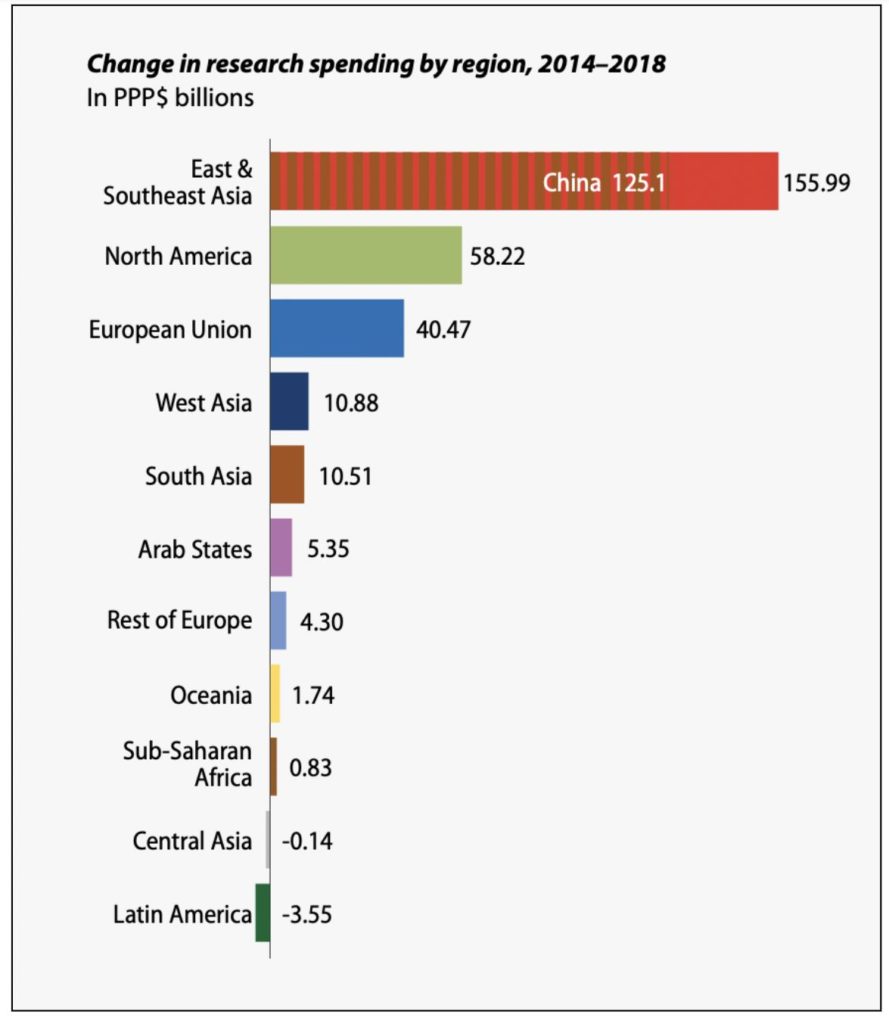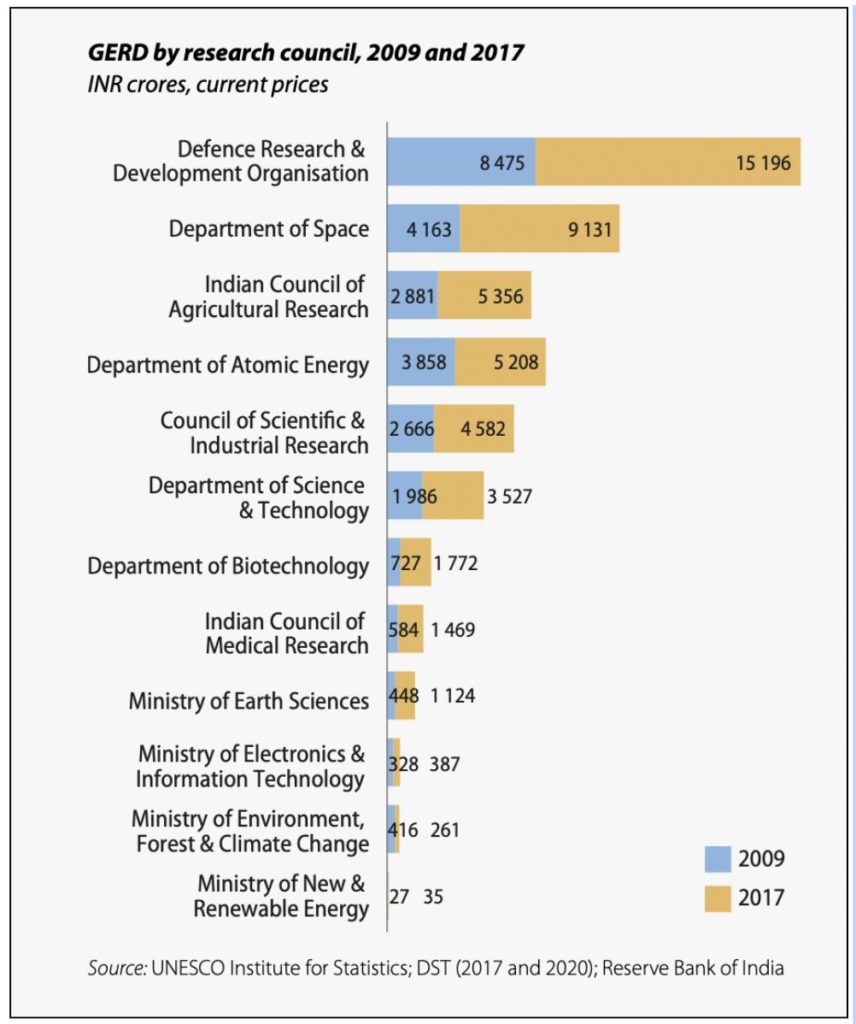UNESCO released the 7th edition of its ‘Science Report’ recently. The report tracks spending of various countries on R&D between 2014 & 2018. Among other things, the report highlights the need for increased R&D spending in India as the current spending is less than 15% of what the USA or China spends on R&D.
The latest edition of the UNESCO Science Report (USR) was released on 11 June 2021. USR is one of the flagship publications of UNESCO (United Nations Educational, Scientific and Cultural Organization) and is published every 5 years.
The USR-2021 is the seventh in the series of UNESCO Science Reports, which was first launched in 1993. The sub-theme for this edition of USR is ‘The race against time for Smarter Development’ and it lays emphasis on the performance and efforts of the countries towards achieving the Sustainable Development Goals (SDGs) targets set for 2030. The report assumes prominence as a third of the timespan (five years) have passed on the way to the 2030 deadline.
Accordingly, many of the countries are aligning their national policies with ‘The 2030 Agenda for Sustainable Development’ and are engaged in the transition towards becoming ‘Green’ economies. Apart from this Green transition, digitalization of public services is also being undertaken to improve service delivery, support business, combat corruption, reduce tax evasion, etc. Scientific developments play a key role in aiding countries achieve this dual green & digital transition.
The latest USR observes that the governments need to increase their commitment towards Research & Development (R&D) to aid this transition.

The trends in R&D spending in various countries is one of the major themes of USR-21. In this story, we look at these trends with special emphasis on India.
Global Research Spending between 2014-18 increased by 19.2% while GDP grew by 14.8%
During the period 2014-18, the Global Investment on Research has outpaced the Economic growth. The global research spending increased by 19.2% while the global economy during this period grew by 14.8%. The value is measured in terms of Purchasing Power Parity (PPP) $ billions, with 2005 constant prices.
Globally, the Gross Domestic Expenditure on R&D (GERD) increased from 1482.68 PPP $ billion in 2014 to 1767.27 PPP $ billion. This translates to an increase of spending on research as a portion of GDP from 1.73% to 1.79%. While the investment in research at a global level looks promising, it is not uniform across the regions & countries with considerable disparities.
Among the various regions, East & Southeast Asia, North America & European Union account for the higher spending on Research.
- East & Southeast Asia which includes major Research spending countries like China, Japan & South Korea account for the highest spending with 714.52 PPP $ billion in 2018, an increase of 28% from their spending in 2014.
- North America & European Union (EU) spent 483.43 PPP $ billion & 330.83 PPP $ billion respectively in 2018, an increase of 13.7% & 13.9% respectively compared to the 2014 figures. The departure of the UK from EU and Geo-political reshuffles could result in a fall in the GERD of the EU, despite no change in their science policy.
- Latin America & Central Asia are the only two regions that have negative growth in their research spending. The report observes that stagnant economic growth & a fall in spending on R&D by traditionally larger spenders like Argentina & Mexico, to be the reasons for the negative growth rate in Latin America.
- South Asia with a GERD of 56.9 PPP $ billion in 2018 has witnessed an increase of 23.8% compared to 2014.

China contributes the highest towards the global increase in R&D spending. Nearly 44% of the global increase in Research spending during 2014-18 is by China. The investment in research by China increased from 313.94 PPP $ billion in 2014 to 439 PPP $ billion in 2018.
- However, even without China, the R&D of the rest of the countries does outpace the economic growth. Excluding China, the expenditure on R&D by the rest of the World grew by 13.6%, while the growth in the economy was 12%.
- USA is the second-highest contributor towards this growth with a 19.4% increase in R&D expenditure. GERD in the USA grew from 401.74 PPP $ billion in 2014 to 460.6 PPP $ billion in 2018.
- Despite being one of the major spenders on R&D, the growth in spending between 2014 & 2018 for Japan has been minimal.
- India & South Korea have reported an increase of 24% & 25.5% respectively in terms of spending on R&D between 2014 to 2018.
Despite the increase, the R&D spending by India is still less than 15% of what the USA & China spend individually.
Israel & South Korea have the highest GERD as share of GDP
The total GERD of Israel in 2018 was 13.81 PPP $ billions, which is around 1/4th of India’s GERD. However, in terms of Research Intensity (RI) i.e., GERD as a share of GDP, it is the highest in the world. The RI of Israel is 4.95% in 2018, which is a further increase from 4.17% in 2014. During this period, it has overtaken South Korea as the most Research-Intensive country.
- RI of South Korea was 4.29% in 2014 and it has further increased its RI to 4.53% in 2018.
- USA, Germany & Japan are among the countries which have a higher GERD as a share of their GDP.
- China, which has the second-highest GERD in 2018, after the USA, has a RI of 2.19% in 2018, an increase from 2.03% in 2014.
- United Arab Emirates (UAE) is among the countries which have a higher increase in its Research Intensity during 2014-18. The RI of UAE increased to 1.3% from the earlier 0.69% in 2014. Its investment in Space Research is one of the major reasons for this increase.
As was the case in GERD, North America, East & Southeast Asia & European Union are the regions that have a higher Research Intensity.
- Most of the other regions lag on this front. Apart from European Free Trade Association & West Asia, the rest of the regions have an RI of less than 1%.
- Apart from the lower RI, a cause of worry for Central Asia & South Asia is that there is a decline in its RI in 2018 compared to 2014.
- This decline is evident in the case of India, the major country in South Asia. The expenditure on research as a share of GDP in India fell from 0.7% in 2014 to 0.65% in 2018 as per the USR-2021.
The difference becomes starker when ‘Per capita GERD’ is taken into consideration. India’s Per Capita GERD is 39.95 PPP $ compared to 1647.67 PPP $ in Israel. In the case of China, which has a larger population than India, it is 307.51 PPP $, more than 7 times that of India. The Per Capita GERD in Mexico & South Africa is 44.27 PPP $ & 90.55 PPP $ respectively.
Despite increase in absolute spending on Research, RI has declined
India’s GERD (at Current prices) increased five-fold during the period 2004-2018. From spending of US $ 3.4 billion in 2004, it has increased to the US $ 17.82 billion for the year 2018.
While there is a considerable increase in the absolute value of research spending over the years, Research Intensity i.e., GERD as a share of GDP has seen a decline since 2014.
In 2008, RI was 0.84 which after a decline in the following two years, increased to 0.91% in 2012 & 2013. However, in 2014, RI reached 0.71% after a sharp decline. It further fell to 0.69% in 2014. Between the 2016 to 2019 period, the Research Intensity remained constant at 0.7%.
It must be noted that the GERD here is calculated as percentage of GDP, and not adjusted to PPP as in case of the earlier figures.

Defence Research constitutes the major share of India’s GERD. In 2017, GERD for the Defence Research & Development Organization (DRDO) was Rs. 15.19 thousand crores, a nearly two-fold increase compared to 2009. The Research spending on Department of Space has also more than doubled during this period from Rs. 4.16 thousand crores to Rs. 9.13 thousand crores.

Comparatively, ICMR’s (Indian Council of Medical Research) GERD is Rs. 1.46 thousand crores in 2017 and that of the Department of Biotechnology (DBT) was Rs. 1.7 thousand crores. The COVID-19 pandemic has highlighted the need for greater spending on research in general & medical research in particular.
As part of Mission Surakasha – The Indian COVID-19 development mission, Rs. 900 crores over a period of 12 months were announced as part of Aatmanirbhar Package 3.0.
Investment on R&D continues to be a challenge for many of the Developing & Underdeveloped countries
Around 93% of the global GERD in 2018 was by G-20 countries. The least developed countries contributed to only around 0.11% of the global share. This vast difference between the developed & under-developed countries highlights the reality of the difference in spending though there has been an overall increase in global GERD.
While it is natural that disparities exist between the stronger economies that are more scientifically inclined and the others, the less than considerable change in the 2014-18 period is a cause for concern.
The disparity can be observed across the regions, as highlighted earlier. While the Research spending has increased in most of the countries, the RI does remain lower, highlighting that the expenditure on research is not commensurate to the economic growth. The situation is worse-off in countries suffering from an economic slowdown.
The symbiotic relationship between Development & Scientific Research presents multiple challenges for the developing & underdeveloped countries as it affects their progress in reaching the SDG targets. While sharing of know-how and scientific knowledge by the developed countries is an option, home-grown local solutions are possible only with investment in R&D.
Data indicates that the level of international collaboration for low-income countries remains high at around 70% while this remains at a lower level in the case of upper-middle-income & lower-middle-income countries.
It is high time that countries like India increase their spending on R&D and also diversify the spending to reach the development targets.
Featured Image: UNESCO Science Report


